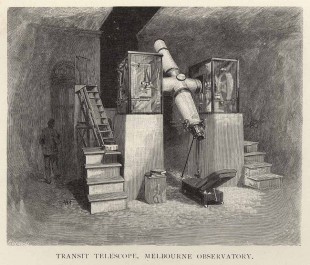…where east meets west
- Home
- Brief History
- The Greenwich Meridian
- Greenwich
(1675–1958) - Herstmonceux
(1948–1990) - Cambridge
(1990–1998) - Outstations (1822–1971)…
- – Chingford (1822–1924)
- – Deal
(1864–1927) - – Abinger
(1923–1957) - – Bristol & Bradford on Avon
(1939–1948) - – Bath
(1939–1949) - – Hartland
(1955–1967) - – Cape of Good Hope
(1959–1971)
- Administration…
- – Funding
- – Governance
- – Inventories
- – Pay
- – Regulations
- – Royal Warrants
- Contemporary Accounts
- People
- Publications
- Science
- Technology
- Telescopes
- Chronometers
- Clocks & Time
- Board of Longitude
- Libraries & Archives
- Visit
- Search
Telescope: Melbourne Reversible Transit Circle (1883)

The Melbourne Reversible Transit Circle. From Picturesque Atlas of Australasia. Sydney [and other places]: Picturesque Atlas Publishing Company, Limited, 1886
Description
Ordered from Troughton & Simms, London, by Robert Ellery in 1881, the telescope was made for the Melbourne Observatory in 1883 and installed there in July 1884. It has an aperture of 8-inches and a focal length of 9 feet. It was based on a design that had already been used by Troughton & Simms for similar instruments at the Cambridge University Observatory in England and the Cambridge University Observatory in Boston, USA. Some reports state it cost £1,400, others around £1300.
The telescope rotated on an axis of 52 inches, with pivots of 4½ inches diameter. The axis carried two divided circles of 3 feet diameter, one fixed and the other movable about the axis. In Melbourne, the axis rested upon solid iron pillars, which themselves rested upon massive piers of bluestone each weighing five tons and rising five feet above the floor of the transit room. The stone piers were bedded on a foundation of bluestone and concrete. The telescope tube was made of gun metal. The telescope came with a pair of collimators of shorter focal length and aperture and an impersonal micrometer to which a motor drive could be readily fitted. Click here to read a description of the telescope as published in The Argus (Melbourne Victoria) on Thursday 11 September 1884.
Planned use at Herstmonceux
Spencer Jones had planned to use the Melbourne instrument for differential observation at Herstmonceux alongside the Cooke Reversible Transit Circle (RTC). It was originally proposed to install the Melbourne instrument first, in a new purpose built pavilion and then move the Cooke instrument from Greenwich. The goalposts then began to move, and it was decided instead to install the Cooke RTC in a new pavilion (designed with good thermal insulation, but low heat capacity in mind), and then re-erect its old pavilion from Greenwich for the Melbourne instrument. By 1955, the Greenwich pavilion was deemed to be too problematic to adapt, and a new pavilion was being proposed for the Melbourne instrument. It was not however to be. With the arrival of Woolley as Astronomer Royal later that same year, all plans for the Melbourne instrument were quietly abandoned and the instrument eventually returned to Melbourne in 1978.
Use of the OG for testing the OG of Flamsteed’s Well Telescope
Flamsteed’s Well Telescope was a source of great fascination for the Observatory’s astronomers from Victorian times onwards. Its Object Glass (OG) which had been presented by Flamsteed’s Assistant, James Hodgson, to the Royal Society in 1737 who loaned it to the Science Museum in 1932. It was loaned briefly back to the Observatory in 1955 so that a series of tests could be conducted to ascertain its optical qualities. These were performed by Alan Hunter and EG Martin, who reported their findings in the journal The Observatory (click here to view). The OG from the Melbourne instrument was used as part of the testing process.
© 2014 – 2025 Graham Dolan
Except where indicated, all text and images are the copyright of Graham Dolan